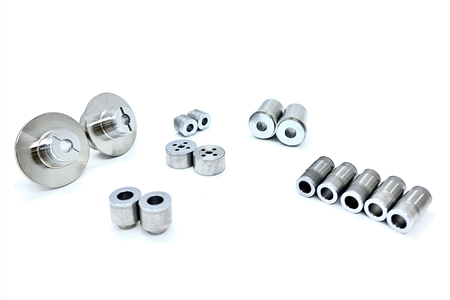
Galvanizing or Galvano technology (named after Italian scientist Luigi Galvani) is the name for electrochemical coating of metal on an object. In the electroplating process, the object to be plated is attached to the cathode (Kathode), the plated metal attaches to the anode (Anode) of DC power in dielectric solution (possibly dilute acids).
At the anode (Anode) occurs metal oxidation, releasing positive metal ions, under electrostatic forces these positive ions will move to the cathode (Kathode), where they receive e- In the process of oxidation, reducing the formation of metal deposits on the surface of the plated object. The thickness of the plating is directly proportional to the electric current of the source and the plating time.
Why Chrome Plating?
In the mechanical processing industry in general and in particular hydraulic engineering in order to meet the requirements of machinery is the need for high accuracy to withstand large loads, high speeds, pressures and large temperatures. Axial ty ben, hydraulic cylinder, crankshaft, Piston, roller ... Over time use during operation will be worn, scratched surface ... the size will be changed as such. affecting the operation of the shaft and related machinery. Therefore, the most common and cost-effective remedy today is surface treatment, grinding, chrome plating, restoring shaft size and creating luster and hardness for specialized products.
Hard chrome plating is widely used in the industry because it offers many superior properties to the surface of machine parts that the material itself does not have. In addition to high hardness, hard chrome plating is also very resistant to corrosion, very good abrasion resistance, smooth and very uniform surface, difficult to wet, small friction coefficient, good attachment. Thanks to these properties, the hard chrome layer makes the surface of machine parts better and very homogeneous in quality, making their working time with high precision be extended.
The chrome coating can be 10 µm - 1000 dàym thick, durable anti-oxidation glossy surface for the product, and features high-class trim and high grip suitable for hydraulic components, rubber, packaging, printing industry, plastic injection industry and molds, products for heavy industry in general ...
Chromium Plating Application?
Hard chrome plating is widely used in industry due to the unique combination of many properties and benefits not owned on any other material available in the market. In many cases, all of these properties are important for successful commercial applications.
Introducing the Industrial Hard Chrome
Deposition of electrolytic chromium into the surface of other materials, mainly metals, occurs when the electrical energy supplied to the electrodes in a solution containing mainly chromic acid is converted into chemical energy to form metal chrome.
Typically, when the machined parts are damaged or worn and no longer functional, hard chromium plating can be used to restore lost metal surfaces and restore their original tolerances. In many cases, the service life and productivity of equipment will be greatly improved.
In addition, for new processed products, hard chrome is used to improve the durability of a wide range of industrial equipment components. Such as:
- The printing industry uses hard chromed copper plates and cylinders to resist corrosion and abrasion.
- Petroleum exploration and production machines of all types have many chromed-plated components of them to extend their service life, improve efficiency and reduce downtime.
- Hydraulic equipment uses chromed plating shaft to prolong service life in corrosive industrial environment.
Common chrome plated products:
- Chromium plating restores a lot of plastic rolling and plastic films
- Hard chrome plating Work roll, Intermediate shaft, back up roll ... for steel industry
- Ty ben, hydraulic cylinders used in rubber industry, packaging, printing industry, heavy industry ...
- Hard chrome plating of steel industry rollers
- Ty ben motor vehicles (excavators, cranes, excavators, loaders ...)
- Press brake
- Ben journeys
- Ben stage
- Dosing machine
- Ty team
- Warehouse forklifts
- Ty ben for barges
- Ty ben brick and tile making machine
- Ty ben system of hydraulic presses, air compressors, rivet guns ...
- Wheel bearings
- Rolls for the steel, aluminum and plastic industries
- Gravure cylinder for printing industry
- Other types of precision engineering and mechanical products ...
Suitable material for Chrome plating?
Any ferrous and non-ferrous metals are suitable for chromium plating. The exception is magnesium and titanium, which usually require a lower layer of zinc, copper or nickel as well as special plating techniques. Aluminum can be chrome plated successfully, but usually requires a layer of copper or nickel under the layer, although some alloys have been plated without lining. In recent years, new techniques have allowed the application of decorative chrome on plastic….
Other posts
Galvanizing or Galvano technology (named after Italian scientist Luigi Galvani) is the name for electrochemical coating of metal on an object. In the electroplating process, the object to be plated is attached to the cathode (Kathode), the plated metal attaches to the anode (Anode) of the DC power source in dielectric solution (possibly dilute acids).
At the anode (Anode) occurs metal oxidation, releasing positive metal ions, under electrostatic forces these positive ions will move to the cathode (Kathode), where they receive e- In the process of oxidation, reducing the formation of metal deposits on the surface of the plated object. The thickness of the plating is directly proportional to the electric current of the source and the plating time.


